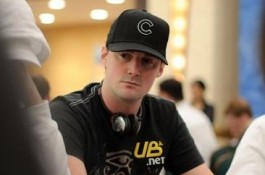Keeping Your Range Open With Ryan D��Angelo, Part 2

In Part 1,Ryan D��Angelo illustrated the concept of keeping your range open by discussing a hand he played during the NAPT Mohegan Sun Main Event. For Part 2, he talks about another hand that he played at the same table in which this week��s concept also applied.
Hand #2
Opponent: Jacobo Fernandez
Blinds: 1,000-2,000 with a 200 ante
So how long after the first hand did the next one happen?
I would say four to five orbits, or maybe 45 minutes later. I had been raising a lot of pots obviously, playing my aggressive style and battling a bit with the guy on my left, Jacobo. I had been winning a lot of hands, but I really hadn��t been getting out of line, but they didn��t know that cause I hadn��t been showing down too much, just making some hands.
What was your history with this opponent?
I played some pots with Jacobo where I would raise and he would flat on my direct left, and I would give up. He continuation bet once, I think, and gave up. When you give up to players like that, I think they expect you to try and make a move soon, which set up my next hand perfectly.
And when I say players like him, I just mean someone whom you deem might be suspicious of you at all times and likely to just not give you credit even when you are representing a strong hand.
Hand: Jacobo Fernandez opened to 5,600 under the gun, and D'Angelo made the call from the big blind with A?A?.
What did you think once you looked down at aces?
I remember as it was folding around to me how sick of a spot this would be to look down at aces, and I just looked down at the aces. It was really freaky actually. When he raised under the gun and it folded all the way around to the big blind if I reraised, it obviously would shrink my range down from like 25 percent of hands to three percent of hands.
Obviously, when he had 170,000 at 1,000-2,000, and I covered him, I wanted to build the pot, but I just didn��t think I could get a lot of chips from a marginal hand of his unless I made it look like I��m was doing something crazy postflop. So, my plan was to call preflop, and check-raise almost any flop and play my aces kind of like they are bottom set. I call 3,200 more, and just threw the chips in like I was calling with ten-eight offsuit.
Hand: The flop comes Q?J?5?. D��Angelo checks and Fernandez bets 11,000. D��Angelo reraises to 28,500, and Fernandez calls.
How did you pick your bet sizing?
At this point, it��s very important to take a moment and kind of set up the rest of the hand in your mind because you don��t want to bet the turn and have there be like a half pot left in his stack in relation to the pot. It��s just bad for your overall game plan. I made it 28,500 and after he calls, there��s 140,000 left in his stack and 65,000 in pot.
Hand: The turn is the 5?. The board now reads Q?J?5?5?. D��Angelo bets 38,500. Fernandez goes all in for 140,000. D��Angleo calls and shows A?A?. Fernandez shows A?7?. The river is the 10? and D��Angelo wins the pot, increasing his stack to 475,000.
It��s a beautiful turn card. Now all I have to worry about is queens and jacks really, which I think he reraises on the flop a fair bit, so I was chillin��. He goes all-in with A?7? and I hold for what, at the time, had to be the biggest pot of the tournament so far I'd imagine.
Did he have fold equity when he shoved?
Yeah, he did for sure. I mean, if I��m value betting the turn for 38,000, I��m probably not folding to a shove. But, I could have a draw that he beats like 9?10?, which I probably just check-call that flop that deep in a big tourney which is a great plan when you're comfortable getting two bets in on a flop like that, but he doesn��t know that. I probably wouldn��t check raise because I might get three bet. Or, I would lead there. Leading is such a great play that people don��t really do enough, especially live. If you��re leading with bottom pair in a three-way raised pot on a flush draw board, you aren��t ever getting raised by an overpair and you can rep the flush if it turns. A lot of people just snap fold everything.
So to summarize our topic this week about keeping your range open, can you recap exactly what it means, and specifically, how you do it preflop?
Basically you want to keep players on their toes as much as possible. When you're doing things with your range all the time in certain spots you can become very predictable and good players will recognize that very quickly on that. This concept is more important against players you play against all the time obviously, because patterns than need to be balanced won��t show up to noticeably over a one live tournament sample, but a good example is a three-betting range.
You don��t want to be just three-betting your good hands because it��s going to be way too easy for someone to play against that. When I raise pocket tens in middle position, and you just haven��t reraised all day and you three-bet from the small blind, I can just throw it away. Now if I��ve seen you being active and showing down three-bets with marginal hands, it��s going to be much more likely you get action when you pick up a big hand.
And another point on polarizing - when you are three-betting middle strength hands like pocket sevens and ace-jack suited, you are just going to be folding the best hand a decent portion of the time when you get four-bet. When you three-bet ten-five suited, you have no problem tossing it in the muck if they don��t fold right away. It��s very dangerous when players can start putting you on one of only a few hands in your range. It��s almost like your cards are face up, and they're going to be able to make very good decisions.
D��Angelo went on to cash in this event in 42nd place for $11,500.
Be sure to follow us on Twitter for up-to-the-minute news.








